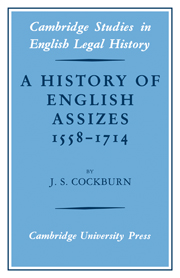Book contents
3 - Preparation for the circuits
Published online by Cambridge University Press: 07 October 2011
Summary
Think you on the solemne 'sizes past
How suddenly in Oxfordshire
I came and made the judges all agast
And justices that did appeare
And took both Bell and Bar am away
And many a worthy man that day
And all their bodies brought to clay.
From The Doleful Dance and Song of Death, etc., a contemporary ballad commemorating the ‘Black’ Oxford Assizes of 1577, quoted in The Life and Times of Anthony Wood, ed. A. Clark, Oxford Hist. Soc. (1891–1900), 1, 104n.Towards the end of the Hilary and Trinity terms the judges gathered in Serjeants' Inn to choose their circuits. Selection was normally by seniority: first the Chief Justice of the King's Bench, his brother in the Common Pleas, and the Chief Baron of the Exchequer, and then the puisnes of the three courts according to seniority of appointment. Together the three benches provided three chiefs and nine puisne judges, all of whom were available after 1579 for circuit work. Vacancies occasioned by illness or attendance in Parliament were normally filled by commissioning Serjeants. A judge was forbidden by statute to ride the circuit in which was located his native county or residence. Permission to avoid this limitation by patent non obstante was, however, granted fairly frequently throughout most of this period. Justice Southcote, whose seat was in Essex, was the principal beneficiary in Elizabeth's reign, riding the Home Circuit without a break from his elevation to the Queen's Bench in 1563 until 1582. Chief Justice Anderson went the Midland Circuit, where his son, Monson, also practised, on twenty consecutive occasions from the summer of 1595 onwards.
- Type
- Chapter
- Information
- A History of English Assizes 1558–1714 , pp. 49 - 62Publisher: Cambridge University PressPrint publication year: 1972

